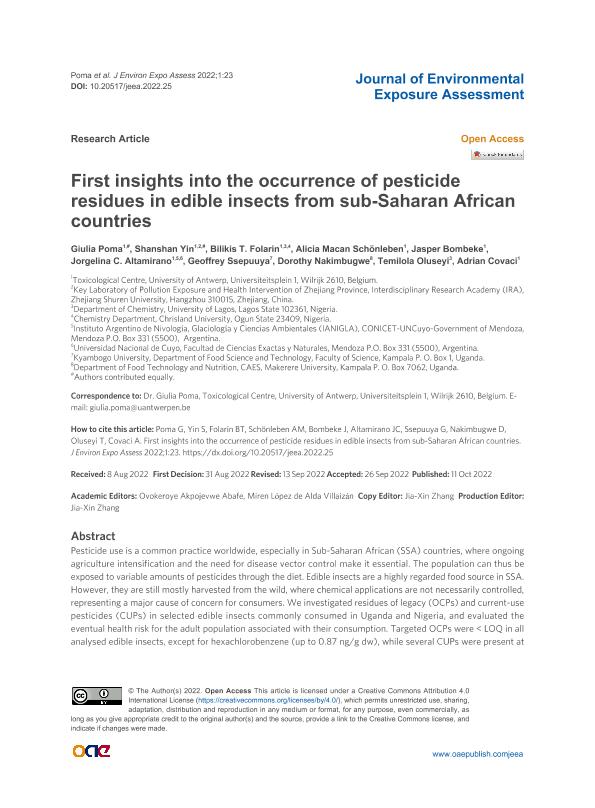Mostrar el registro sencillo del ítem
dc.contributor.author
Poma, Giulia

dc.contributor.author
Yin, Shanshan
dc.contributor.author
Folarin, Bilikis T.
dc.contributor.author
Schönleben, Alicia Macan
dc.contributor.author
Bombeke, Jasper
dc.contributor.author
Altamirano, Jorgelina Cecilia

dc.contributor.author
Ssepuuya, Geoffrey
dc.contributor.author
Nakimbugwe, Dorothy
dc.contributor.author
Oluseyi, Temilola
dc.contributor.author
Covaci, Adrian

dc.date.available
2023-07-17T13:20:18Z
dc.date.issued
2022-08
dc.identifier.citation
Poma, Giulia; Yin, Shanshan; Folarin, Bilikis T.; Schönleben, Alicia Macan; Bombeke, Jasper; et al.; First insights into the occurrence of pesticide residues in edible insects from sub-Saharan African countries; OAE Publishing; Journal of Environmental Exposure Assessment; 1; 4; 8-2022; 1-14
dc.identifier.issn
2771-5949
dc.identifier.uri
http://hdl.handle.net/11336/204114
dc.description.abstract
Pesticide use is a common practice worldwide, especially in Sub-Saharan African (SSA) countries, where ongoing agriculture intensification and the need for disease vector control make it essential. The population can thus be exposed to variable amounts of pesticides through the diet. Edible insects are a highly regarded food source in SSA. However, they are still mostly harvested from the wild, where chemical applications are not necessarily controlled, representing a major cause of concern for consumers. We investigated residues of legacy (OCPs) and current-use pesticides (CUPs) in selected edible insects commonly consumed in Uganda and Nigeria, and evaluated the eventual health risk for the adult population associated with their consumption. Targeted OCPs were < LOQ in all analysed edible insects, except for hexachlorobenzene (up to 0.87 ng/g dw), while several CUPs were present at notable levels. Cypermethrin showed the highest median concentration (17 ng/g dw), while the Nigerian cricket Brachytrupes membranaceus was the most contaminated sample, with concentrations of aldicarb, propoxur, chlorpyrifos, dichlorvos and paclobutrazol reaching 118 ng/g dw, 327 ng/g dw, 156 ng/g dw, 26 ng/dw, and 14 ng/g dw, respectively. The concentrations of pesticides were generally well below the available maximum residue levels (MRLs), and the dietary risk assessment did not indicate health threats for the adult population. However, we suggest that the monitoring of the chemical safety of edible insects in SSA should be further investigated and insects should be integrated into more extensive dietary studies.
dc.format
application/pdf
dc.language.iso
eng
dc.publisher
OAE Publishing
dc.rights
info:eu-repo/semantics/openAccess
dc.rights.uri
https://creativecommons.org/licenses/by/2.5/ar/
dc.subject
LEGACY PESTICIDES
dc.subject
CURRENT-USE PESTICIDES
dc.subject
ENTOMOPHAGY
dc.subject
UGANDA
dc.subject
NIGERIA
dc.subject
HUMAN EXPOSURE
dc.subject.classification
Otras Ciencias de la Tierra y relacionadas con el Medio Ambiente

dc.subject.classification
Ciencias de la Tierra y relacionadas con el Medio Ambiente

dc.subject.classification
CIENCIAS NATURALES Y EXACTAS

dc.title
First insights into the occurrence of pesticide residues in edible insects from sub-Saharan African countries
dc.type
info:eu-repo/semantics/article
dc.type
info:ar-repo/semantics/artículo
dc.type
info:eu-repo/semantics/publishedVersion
dc.date.updated
2023-07-05T15:28:13Z
dc.journal.volume
1
dc.journal.number
4
dc.journal.pagination
1-14
dc.journal.pais
Reino Unido

dc.description.fil
Fil: Poma, Giulia. Universiteit Antwerp; Bélgica
dc.description.fil
Fil: Yin, Shanshan. Universiteit Antwerp; Bélgica. Zhejiang Shuren University; China
dc.description.fil
Fil: Folarin, Bilikis T.. Universiteit Antwerp; Bélgica. University Of Lagos; Nigeria. Chrisland University; Nigeria
dc.description.fil
Fil: Schönleben, Alicia Macan. Universiteit Antwerp; Bélgica
dc.description.fil
Fil: Bombeke, Jasper. Universiteit Antwerp; Bélgica
dc.description.fil
Fil: Altamirano, Jorgelina Cecilia. Consejo Nacional de Investigaciones Científicas y Técnicas. Centro Científico Tecnológico Conicet - Mendoza. Instituto Argentino de Nivología, Glaciología y Ciencias Ambientales. Provincia de Mendoza. Instituto Argentino de Nivología, Glaciología y Ciencias Ambientales. Universidad Nacional de Cuyo. Instituto Argentino de Nivología, Glaciología y Ciencias Ambientales; Argentina. Universidad Nacional de Cuyo. Facultad de Ciencias Exactas y Naturales; Argentina. Universiteit Antwerp; Bélgica
dc.description.fil
Fil: Ssepuuya, Geoffrey. Kyambogo University; Uganda
dc.description.fil
Fil: Nakimbugwe, Dorothy. Makerere University; Uganda
dc.description.fil
Fil: Oluseyi, Temilola. University Of Lagos; Nigeria
dc.description.fil
Fil: Covaci, Adrian. Universiteit Antwerp; Bélgica
dc.journal.title
Journal of Environmental Exposure Assessment
dc.relation.alternativeid
info:eu-repo/semantics/altIdentifier/url/https://www.oaepublish.com/jeea/article/view/5227
dc.relation.alternativeid
info:eu-repo/semantics/altIdentifier/doi/http://dx.doi.org/10.20517/jeea.2022.25
Archivos asociados
